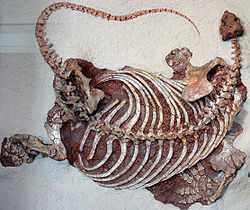Caseidae
| Caseidae Temporal range: Late Carboniferous - Middle Permian, 300–251Ma | |
|---|---|
 | |
| Fossil skeleton of Cotylorhynchus romeri | |
| Scientific classification | |
| Kingdom: | Animalia |
| Phylum: | Chordata |
| Clade: | Synapsida |
| Clade: | †Caseasauria |
| Family: | †Caseidae Williston, 1912 |
| Genera | |
|
Alierasaurus | |
Caseidae is an extinct family of synapsids from the Carboniferous and Permian period. It was a widespread group of very primitive herbivorous synapsids, which appeared during the late Carboniferous and persisted until the late middle Permian.
Description
All caseids, whether modest or enormous, are characterized by small cervical vertebrae, bulky, barrel-shaped bodies and relatively massive limbs. Although ranging in size from 1 to 5½ meters (3–18 feet) in body length, caseids were surprisingly conservative in their skeletal anatomy and body proportions. All were large animals with small heads and barrel-like bodies. Some, like Angelosaurus and Cotylorhynchus, which exceeded 4 meters long and were the largest of the pelycosaurs, seemed to have played the same ecological role during the later part of the early Permian that the pareiasaurs and herbivorous dinocephalians did during the Middle and Late Permian.

Skull
The caseid skull is distinctive in the presence of large temporal openings, enormous external nares (probably to house some kind of sensory or moisture-conserving organ), and large pineal opening, and a snout or upper jaw that dramatically overhangs the tooth row to form a forward projecting rostrum. The external surface of the skull is sculpted with rounded deep pits and sometimes crevice-like depressions. The marginal teeth are quite similar to the teeth of pareiasaurs. In contrast to most other synapsids, except Edaphosaurus, and as befits the herbivorous lifestyle, the teeth are remarkably uniform. There is a general reduction in the number of marginal teeth and cheek teeth.
See also
References
- Romer, AS & Price L.I (1940), Review of the Pelycosauria. Geol. Soc. Amer. Spec. Papers 28: 1-538.
- Reisz, R. R., 1986, Handbuch der Paläoherpetologie – Encyclopedia of Paleoherpetology, Part 17A Pelycosauria Verlag Dr. Friedrich Pfeil, ISBN 3-89937-032-5
External links
| |||||||||||||||||||||||||||||||||||||||||||||||||||||||||||||||||||||||
